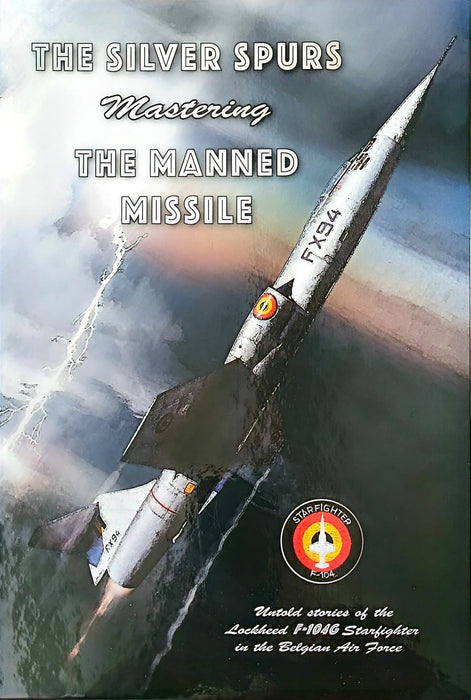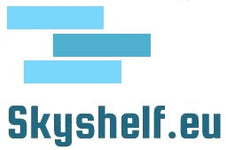
The Silver Spurs - Mastering the manned missile (2025) (imprimé)
Les éperons d'argent
Maîtriser le missile piloté
Histoires inédites du Lockheed F-104G Starfighter dans l'armée de l'air belge
Editeur responsable : Wilfried de Brouwer
Editeur : Vieilles Tiges de l'Aviation Belge
Ce livre unique décrit le pilotage du mythique Starfighter,
Il couvre la genèse, l'achat de plus de 1.350 avions par les quatre partenaires européens du consortium et l'emploi opérationnel du F-104G dans l'armée de l'air belge. La particularité de ce livre réside dans le fait que plus de quarante pilotes ont raconté les événements particuliers qu'ils ont vécus à bord de cet appareil. Certains ont survécu de justesse à leur épreuve, d'autres ont sauvé leur vie grâce à la fiabilité du système et à leurs compétences professionnelles. Mais tous sont fiers d'avoir eu l'occasion de maîtriser ce « missile habité ».
Ce livre rend également hommage aux 23 pilotes qui ont perdu la vie aux commandes du Starfighter en défendant notre liberté pendant la guerre froide. Ils ont contribué efficacement à la libération des pays d'Europe de l'Est qui étaient, à l'époque, dominés par le régime communiste soviétique,
Vous apprécierez la lecture de ce livre, car il vous donne une vue de l'intérieur de ce qu'était l'exploitation d'un avion de combat bisonique dans les années soixante et soixante-dix.
La publication de ce livre est parrainée par l'association des aviateurs Senlor, « Les Vieilles Tiges de l'aviation belge ». Cette association regroupe des aviateurs civils et militaires et des passionnés d'aviation pour entretenir des liens d'amitié et conserver le souvenir de leurs prédécesseurs.
292 pages - en anglais - Couverture rigide A4
Table des matières
Chapter 1: The birth and diffIcult early years of the Starfighter
1.1. Design
1.2. The engine
1.3. USAF approach
1.4. The XF-104
1.4.1. XF-104 flight testing begins
1.4.2. Phase 1- Air worthiness
1.4.3. Phase 2 — Flight testing X-F104 by USAF test pilots
1.4.4. Testing XF-104 number Two
1.4.5. Interim evaluation
1.5. The YF-104A
1.5.1. First tests by USAF on YF-104A
1.5.2. Evaluation
1.5.3. YF-104A Disposition
1.6. The F-104A
1.6.1. Ongoing F-104A developments
1.6.2. F-104A enters service
1.7. The F-104C fighter bomber
1.7.1. Add-ons to the F-104A
1.7.2. To Vietnam
1.8. USAF NF-104A and NASA F-104N
1.8.1. NF-104A
1.8.2. NASA F-104N
1.9. Synopsis
Chapter 2: The European consortium
2.1. Geopolitical context
2.2. The difficult resurrection of the Luftwaffe
2.3. Prospecting for a new aircraft
2.4. The birth of an F-104 consortium in Western Europe
2.4.1. NASMO (NATO Starfighter Management Programme Office)
2.4.2. LWG (Logistics Working Group)
2.5. Consortium orders and worldwide production
Chapter 3. The (T)F-1046 in Belgium
3.1. The mission
3.2. Conversion
3.2.1. Pilots' check-out
3.2.2. Technicians' converslon
3.3. Introduction and operational employment 1 Wing (Air Defence)
3.3.1. The Initial Phase
3.3.2 QRA Air Defence
3.3.3. Ground environment
3.3.4. Air-to-air weapons
3.3.5. Mission profiles
3.3.6. The role of the F-104 in NATO's air defence belt
3.3.7. MFFO — Mixed Fighter Force Operations
3.3.8. Operational training
3.3.9. The end of the F-104 era in Beauvechain
3.4. Introduction and operational employment 10 Wing (Ground attack)
3.4.1. Strike mission
3.4.2. A new strategic doctrine
3.4.3 Conventional air warfare
3.4.4. Operational training
3.5. Advanced training for bath fighter and fighter-bomber pilots
3.5.1. The F-104 Tactical Fighter Manual
3.5.2. Fighter Weapons Instructor Training (FWIT) and Tactical Leadership Programme (TLP)
3.5.3. DACT (Dissimilar Air Combat Training)
3.6. Farewell to the BAF F-104
3.7. Closing thoughts on F-104G employment in the Belgian Air Force
Chapter 4. Accidents & Airshows
4.1. The Start
4.2. Accidents in the Luftwaffe
4.2.1. 1962: the crash in Norvenich
4.2.2. Actions in the Luftwaffe
4.2.3. The press campaign in Germany
4.2.4. Further evolution in the Luftwaffe
4.2.5. Overview of accident rate
4.3. Accidents in the Belgian Air Force
4.4. Demos with Starfighter in the Belgian Air Force
4.4.1. Guidelines?
4.4.2. Starfighter demos by Belgian pilots
4.4.3. Revision of the concept
4.4.4. The Slivers era 4.5. Synopsis
Chapter 5. Events
5.1. Introduction
5.2 Bernard Neefs' record flight Brussels Paris
5.3. NATO's air structures in Europe's Central Region
5.3.1. Overall command structures
5.3.2. The air competitions
5.4. Belgian F-104 participations into the AIRCENT competitions
5.4.1. The Guynemer trophy (1966)
5.4.2. 5th Tactical Weapons Meeting in Chaumont (USAF FR)1966
5.4.3. 6th Tactical Weapons Meet in Wildenrath (RAF GE) 1967
5,4.4. 7th Tactical Weapons Moot In Jever (GE) 1968
5.4.5. 8th Tactical Weapons Meeting In Norvenich (GE) 1969
5.4.6. 9th Tactical Weapons Meeting In Spangdahlem (USAF GE) 1970
5,4.7.11th Tactical Weapons Meeting In Sóllingen (CAF-GE)1974
5,4.8. Tactical Air Meeting at RAF In Wildenrath (GE) 1978
5.4.9. Summary Tactical Air Meets F-104G
5.5. National Trophy for Sports Merit
5.6. HM King Baudouin's interest in the Starfighter
5.6.1 Meeting the first Silver Spurs and receiving his Wings
5.6.2. The Mach 2 flight of HM King Baudouin
5.6.3. H.M. King Baudouin visits Kleine-Brogel on 24 October 1973
5.7. The NATO Tiger Association
Chapter 6. Personal experiences
6.1. The first BAF F-104 loss (bail-out)
6.2. Landing with one main gear up
6.3. The adventures of a test pilot
6.3.1. Flame-out landing
6.3.2. More F-104 adventures
6.4. Experiences in marginal weather conditions
6.4.1. Frozen stick landing
6.4.2. Blind night landing
6.4.3. Luckily our new C.O. had the lead
6.4.4. Taking-off with slush on the runway
6.5. Midair collisions
6.5.1. 1/100th of a second can make the difference
6.5.2. A tragic mishap to happen
6.5.3. Midair during Tiger fly-by
6.6. The miraculous saving of Guy Ghys
6.7. AMF Aalborg
6.8. Compressor stall at night
6.9. Nosewheel problems
6.9.1. Collapse of the nosewheel axis
6.9.2. Last flight
6.9.3. How to repair a nosewheel
6.10. Straight from Silver Wings to Starfighter
6.10.1. My conversion to the Starfighter
6.10.2. Converting to the fighter business
6.11. Starfighters in Luke AFB, Phoenix, Arizona
6.12. TLP Experience
6.12.1. Tactical Leadership Programme (TLP) at Jever
6.12.2. Ferry flight TLP Jever (GE) 11-03-1983
6.13. Large formations
6.13.1. Picturing a large formation
6.13.2. Mass take-off and flypast in Brustem
6.14. A wild story
6.15. A few memories
6.16. Collision with my own rocket
6.17. Conversion of the 10 Wing Squadrons
6.18. Nozzle problems
6.18.1. Open nozzle In night flyIng
6.18.2. Nozzle problems after Inverted flight
6.19 Bird strikes
6.19.1. The smell of burned chicken
6.19.2. Surprise above the Ardennes
6.19.3. Ducks fly at night
6.19.4. A bird strike with dramatic consequences
6.20.September 16, 1980. Last flight of the FX 54
6.21. Bye bye BAF F-104
6.22. Surprising snags
6.22.1. When Fighter pilots must navigate
6.22.2. F-104 Silent flight
6.22.3. Zero on the counter
6.22.4. A towing incident in Solenzara
6.22.5. The day I lost my tip tanks
6.22.6. A missing page
6.22.7. The Turkish way, 50 years ago
6.22.8. No dampers
6.22.9. Mirage 5 saved by a F-104 dragchute
6.22.10. Low and heavy
6.22.11. Two years on the manned missile
6.22.12. Lightning strike
6.22.13. Airtac experiences
6.22.14. The reanimation of a stored F-104
Chapter 7. Anecdotes
7.1. The pigs of 31 Sqn
7.2. Fire Power Demo
7.3. The revenge of the devilish geese
7.4. Devils versus Tigers
7.4.1. The painting of the Tiger Squadron
7.4.2. The trees of 23 Squadron
7.4.3. Operation Pussy car - The revenge of the Devils
Annexes
1. List of Silver Spurs
2. Silver Spurs killed in action
3. Commanding officers F-104 units
4. BAF (T)F-104G fleet history
5. Misson planning F-104 in the 10 Wing
6. Starfighter insigna
7. Tiger Outfits
8. The industrial participation in the Belgian F-104 programme
9. Contribution of SABCA into World-Wide Production
10. Pinocchio
11. Zero length launch (ZELL)
























